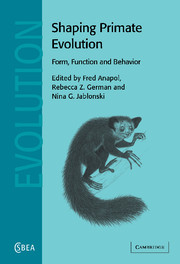Book contents
- Frontmatter
- Contents
- List of contributors
- Preface: shaping primate evolution
- 1 Charles Oxnard: an appreciation
- Part I Craniofacial form and variation
- Part II Organ structure, function, and behavior
- Part III In vivo organismal verification of functional models
- Part IV Theoretical models in evolutionary morphology
- Part V Primate diversity and evolution
- Index
Part II - Organ structure, function, and behavior
Published online by Cambridge University Press: 10 August 2009
- Frontmatter
- Contents
- List of contributors
- Preface: shaping primate evolution
- 1 Charles Oxnard: an appreciation
- Part I Craniofacial form and variation
- Part II Organ structure, function, and behavior
- Part III In vivo organismal verification of functional models
- Part IV Theoretical models in evolutionary morphology
- Part V Primate diversity and evolution
- Index
Summary
My own earliest studies tried to understand functional adaptation in the locomotor system, primarily of bones and joints, through morphometrics. As a preliminary, however, I did attempt to find out what I could of the muscles that moved the bone–joint unit. In those days all we did was dissect muscles and measure them through relative lengths, directions of pull, relative weights, and frequencies of (what were called in those days) muscular anomalies. Limited though such studies were, they were incredibly time-consuming. In all, I dissected 52 shoulders representing 28 primate species, 145 arms and forearms representing 27 primate species, and 167 hips and thighs in 33 primate species. That took many years. Yet even such primitive data provided useful initial information about muscles in relation to the respective bone–joint units.
But it was always clear to me, and I wrote about it without ever doing it, that better muscular studies would be necessary. Such studies would need to understand much more about muscular architecture than simply relative muscle weights, much more about muscle activity and functions through studies of living muscle than just anatomical inferences, much more about movements, postures, and overall behaviors of the living animals than just simple classifications of locomotion.
However, I certainly did not, in those early days, envisage the possibility of studies of the biomechanics of the jaws and teeth and, further, the biomechanics of food being masticated by them. And I knew nothing at all of functional adaptations in the brain.
A few examples of such investigations follow in this section. Again, my students and colleagues have gone so much further than was possible for me. Yet notwithstanding, stimulated by them, I have been able in these latter years to enter some of these areas myself.
- Type
- Chapter
- Information
- Shaping Primate EvolutionForm, Function, and Behavior, pp. 97 - 98Publisher: Cambridge University PressPrint publication year: 2004

